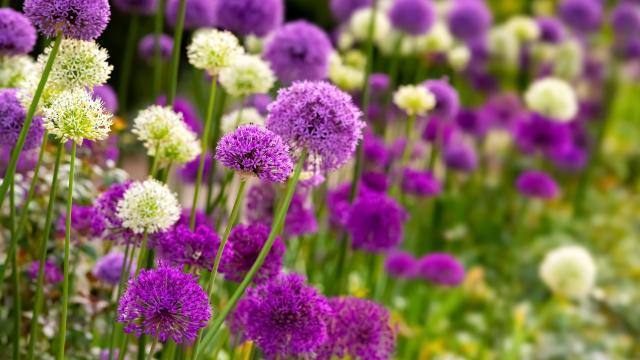Planning your garden can be a challenge when it comes to weighing both form and function, but you don’t have to choose between a flower garden and an edible one. You can get the best of both worlds by planting an edible flower garden, which is perfect for adding a splash of colour to your plate, as well as your yard.
There are many edible plants that have flowers and can be added to your garden beds without too much effort. In addition to cultivated flowers you can grow from seed or starts, it’s worth looking into local native varieties of edible flowers, as well, because they are beneficial for pollinators and local wildlife. (You can find your community’s local native species of wildflowers via this tool from the National Wildlife Foundation, or through a local horticulture society or parks department.)
Why you should plant alliums in your edible garden
While it might not seem like an obvious choice, onions and their relatives that you might usually consider growing only in a vegetable garden actually have beautiful, edible flowers. Plants in the allium family have edible blooms in a variety of heights and colours, making them a good choice for an edible garden.
For example, chives grow purple tufted flowers that are both edible and help discourage aphids from snacking on your greenery. You might also try wild onions, which are also great for deterring aphids and come in several varieties. Other related plants with lovely, edible flowers include wild garlic, drumstick allium, and Persian blue allium.
Why you should plant herbs in your edible garden
Some plants that traditionally grown used for their leaves, like herbs, also have edible flowers that can add both flavour and colour to your plate. Dill, for example, can be planted in a flower garden and you can eat its tiny yellow blooms, as well as the lacy leaves. Other herbs with edible flowers include anise hyssop, mint, and chamomile.
Many of the herbs that are traditionally cultivated for the use of their leaves also have edible flowers, so they are a great choice for an edible flower garden. In addition to their look and taste, many herb plants give off a pleasant aroma, which is an added bonus.
Planting decorative flowers that are edible
Some plants that aren’t traditionally grown for food have edible flowers, too. These include marigolds, which also act as a deterrent for pests and are great for attracting pollinators. Other varieties of decorative flowers you can eat include nasturtiums, pansies, and lilacs. Mixing taller varieties, like lilacs or drumstick alliums, with lower flowers, like pansies, will create depth and give your garden lots of beautiful layers.
The benefits of kits and mixes
If you’re not quite prepared to hand-select your flowers, you can get an assortment of edible flower seeds or a kit for growing edible flowers. Edible wildflower mixes are also available, but you should make sure you’re getting flowers that are native to your region for best results.
Be cautious about purchasing mixes if you’re looking for a wide variety of flowers, as some of the premixed seeds have lots of one type or are made from sweepings and might be contaminated with other seeds. Getting your edible flower seeds from a source that can tell you their germination rate and seed content is a good way to make sure you’re getting a quality product.

Leave a Reply
You must be logged in to post a comment.